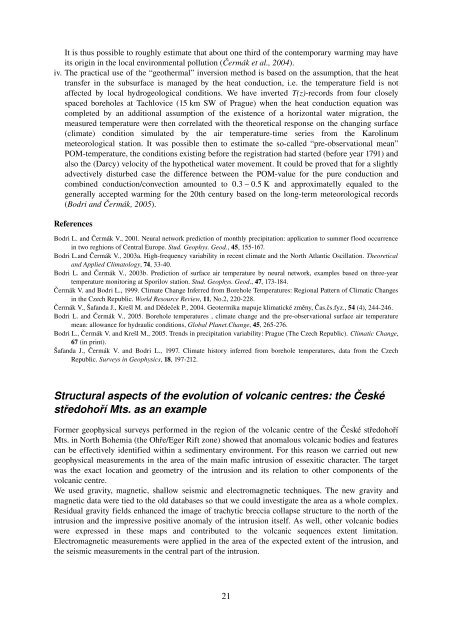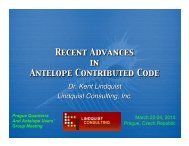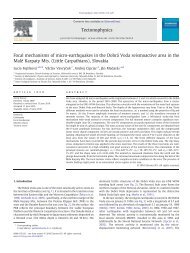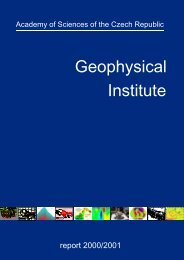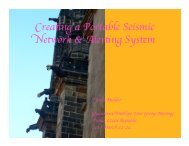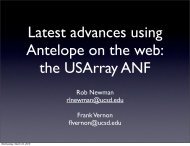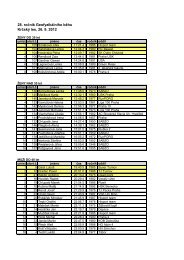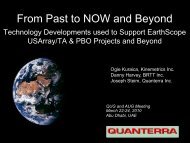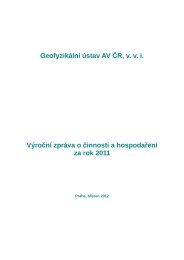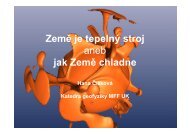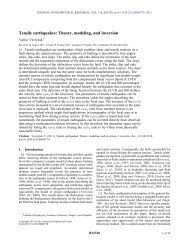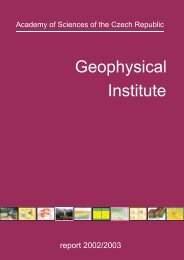Geophysical Institute of the ASCR
Geophysical Institute of the ASCR
Geophysical Institute of the ASCR
Create successful ePaper yourself
Turn your PDF publications into a flip-book with our unique Google optimized e-Paper software.
It is thus possible to roughly estimate that about one third <strong>of</strong> <strong>the</strong> contemporary warming may have<br />
its origin in <strong>the</strong> local environmental pollution (Čermák et al., 2004).<br />
iv. The practical use <strong>of</strong> <strong>the</strong> “geo<strong>the</strong>rmal” inversion method is based on <strong>the</strong> assumption, that <strong>the</strong> heat<br />
transfer in <strong>the</strong> subsurface is managed by <strong>the</strong> heat conduction, i.e. <strong>the</strong> temperature field is not<br />
affected by local hydrogeological conditions. We have inverted T(z)-records from four closely<br />
spaced boreholes at Tachlovice (15 km SW <strong>of</strong> Prague) when <strong>the</strong> heat conduction equation was<br />
completed by an additional assumption <strong>of</strong> <strong>the</strong> existence <strong>of</strong> a horizontal water migration, <strong>the</strong><br />
measured temperature were <strong>the</strong>n correlated with <strong>the</strong> <strong>the</strong>oretical response on <strong>the</strong> changing surface<br />
(climate) condition simulated by <strong>the</strong> air temperature-time series from <strong>the</strong> Karolinum<br />
meteorological station. It was possible <strong>the</strong>n to estimate <strong>the</strong> so-called “pre-observational mean”<br />
POM-temperature, <strong>the</strong> conditions existing before <strong>the</strong> registration had started (before year 1791) and<br />
also <strong>the</strong> (Darcy) velocity <strong>of</strong> <strong>the</strong> hypo<strong>the</strong>tical water movement. It could be proved that for a slightly<br />
advectively disturbed case <strong>the</strong> difference between <strong>the</strong> POM-value for <strong>the</strong> pure conduction and<br />
combined conduction/convection amounted to 0.3 – 0.5 K and approximatelly equaled to <strong>the</strong><br />
generally accepted warming for <strong>the</strong> 20th century based on <strong>the</strong> long-term meteorological records<br />
(Bodri and Čermák, 2005).<br />
References<br />
Bodri L. and Čermák V., 2001. Neural network prediction <strong>of</strong> monthly precipitation: application to summer flood occurrence<br />
in two reghions <strong>of</strong> Central Europe. Stud. Geophys. Geod., 45, 155-167.<br />
Bodri L.and Čermák V., 2003a. High-frequency variability in recent climate and <strong>the</strong> North Atlantic Oscillation. Theoretical<br />
and Applied Climatology, 74, 33-40.<br />
Bodri L. and Čermák V., 2003b. Prediction <strong>of</strong> surface air temperature by neural network, examples based on three-year<br />
temperature monitoring at Sporilov station. Stud. Geophys. Geod., 47, 173-184.<br />
Čermák V. and Bodri L., 1999. Climate Change Inferred from Borehole Temperatures: Regional Pattern <strong>of</strong> Climatic Changes<br />
in <strong>the</strong> Czech Republic. World Resource Review, 11, No.2, 220-228.<br />
Čermák V., Šafanda J., Krešl M. and Dědeček P., 2004. Geotermika mapuje klimatické změny, Čas.čs.fyz., 54 (4), 244-246.<br />
Bodri L. and Čermák V., 2005. Borehole temperatures , climate change and <strong>the</strong> pre-observational surface air temperature<br />
mean: allowance for hydraulic conditions, Global Planet.Change, 45, 265-276.<br />
Bodri L., Čermák V. and Krešl M., 2005. Trends in precipitation variability: Prague (The Czech Republic). Climatic Change,<br />
67 (in print).<br />
Šafanda J., Čermák V. and Bodri L., 1997. Climate history inferred from borehole temperatures, data from <strong>the</strong> Czech<br />
Republic. Surveys in Geophysics, 18, 197-212.<br />
Structural aspects <strong>of</strong> <strong>the</strong> evolution <strong>of</strong> volcanic centres: <strong>the</strong> České<br />
středohoří Mts. as an example<br />
Former geophysical surveys performed in <strong>the</strong> region <strong>of</strong> <strong>the</strong> volcanic centre <strong>of</strong> <strong>the</strong> České středohoří<br />
Mts. in North Bohemia (<strong>the</strong> Ohře/Eger Rift zone) showed that anomalous volcanic bodies and features<br />
can be effectively identified within a sedimentary environment. For this reason we carried out new<br />
geophysical measurements in <strong>the</strong> area <strong>of</strong> <strong>the</strong> main mafic intrusion <strong>of</strong> essexitic character. The target<br />
was <strong>the</strong> exact location and geometry <strong>of</strong> <strong>the</strong> intrusion and its relation to o<strong>the</strong>r components <strong>of</strong> <strong>the</strong><br />
volcanic centre.<br />
We used gravity, magnetic, shallow seismic and electromagnetic techniques. The new gravity and<br />
magnetic data were tied to <strong>the</strong> old databases so that we could investigate <strong>the</strong> area as a whole complex.<br />
Residual gravity fields enhanced <strong>the</strong> image <strong>of</strong> trachytic breccia collapse structure to <strong>the</strong> north <strong>of</strong> <strong>the</strong><br />
intrusion and <strong>the</strong> impressive positive anomaly <strong>of</strong> <strong>the</strong> intrusion itself. As well, o<strong>the</strong>r volcanic bodies<br />
were expressed in <strong>the</strong>se maps and contributed to <strong>the</strong> volcanic sequences extent limitation.<br />
Electromagnetic measurements were applied in <strong>the</strong> area <strong>of</strong> <strong>the</strong> expected extent <strong>of</strong> <strong>the</strong> intrusion, and<br />
<strong>the</strong> seismic measurements in <strong>the</strong> central part <strong>of</strong> <strong>the</strong> intrusion.<br />
21


